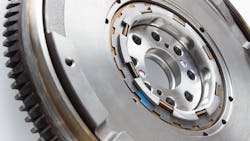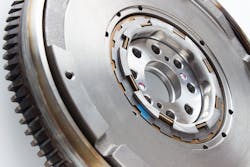Turning Flywheels into Mechanical Batteries
Generating electricity from renewable solar and wind sources has two inherent problems: The sun doesn’t always shine and the wind isn’t always blowing. As a consequence, using electricity from these renewable sources efficiently requires storing it for when it is needed.
In recent years, the two most common methods of storing electricity have involved large lithium-ion batteries and reverse hydropower, in which water is pumped uphill and stored, then sent down through turbine generators when the electricity is needed. Another way to store electricity or energy is to use it to split water into hydrogen and oxygen and then burn the hydrogen later to create electricity.
Fortunately, a better option for storing renewable electricity may exist—one involving the use of flywheels. A flywheel has a dual-function electric motor to store and generate energy. It uses electricity to spin the flywheel so that it is storing kinetic energy, and the faster it spins, the more energy it stores.
Then, when required, the kinetic energy in the flywheel spins a generator’s rotor, producing electricity. Using this energy to drive a generator reduces the flywheel’s rotational speed, a consequence of the principle of energy conservation. In practice, flywheels can be considered mechanical batteries.
The U.S. Navy needed a way to provide energy to new directed-energy weapons. Generators provide sustained power, but not quickly enough for the needed short bursts of high power. The Navy currently uses banks of lithium-ion batteries and, although they can provide energy rapidly, they contain hazardous materials and pose risks to warships. They are also prone to thermal runaway (catching fire) and tend not to work well at high and low temperatures.
To solve this problem, a team of engineers from Vishwa Robotics and the Massachusetts Institute of Technology designed a mechanical battery that uses an array of flywheels housed inside a box. In general, flywheels can’t compete with chemical batteries in terms of energy storage. However, this new approach is a collection of smaller flywheels units rather than a single large flywheel. This lets individual small flywheels spin much faster, thereby storing much more kinetic energy.
Also, specially created bearings make the small flywheels more efficient and cost-effective, and able to store more energy than a lithium-ion battery of the same weight and release it faster with no thermal risks.
The new design has software that manages the flywheel array, monitoring and drawing power from different wheels to match demand. Vishwa Robotics believes that the mechanical battery can be used in a wide range of applications, including domestic and industrial energy storage, and can be scaled to any size.
In addition, the materials used in the mechanical battery are more widely available than those required for chemical batteries. Unlike chemical batteries, which become less efficient after a few hundred charge/discharge cycles, the mechanical battery shows no effect after tens of thousands of cycles.
However, experience has shown that flywheels can disintegrate due to forces created by spinning. This means the design, mechanics and materials need to be carefully selected. Advanced flywheel-based energy storage devices have rotors made of high-strength carbon-fiber composites that are suspended by magnetic bearings and spinning at speeds from 20,000 to over 50,000 rpm in a vacuum enclosure. These flywheels come up to speed in a matter of minutes, reaching their energy capacity much more quickly than some other forms of energy storage.
Compared with other ways to store electricity, flywheels have long lifetimes and require little or no maintenance. Full-cycle lifetimes for the flywheel devices range from 105 to 107 cycles of use, and energy levels between 360 and 500 kJ/kg. The devices have large maximum power outputs and energy efficiencies, also known as round-trip efficiency, as high as 90%.
Unfortunately, flywheels cannot be used for longer-term energy storage if they are not regularly topped-up, as energy losses dissipate the stored energy (albeit slowly). This limitation can be overcome if one day’s production of renewable electricity can be used within a couple of days and the system is continually topped-up.
The U.S. Navy awarded a two-year development contract for the mechanical battery in April 2021, which will include testing performance and safety under various conditions. The device will be evaluated for supplying power not just for weapons but for sensors and propulsion—for example, in uncrewed submarines—and for backup power.
David Whitby is chief executive of Pathmaster Marketing Ltd. in Surrey, England. A slightly different version of this article first appeared in Tribology & Lubrication Technology (TLT), the monthly magazine of the Society of Tribologists and Lubrication Engineers, an international not-for-profit professional society headquartered in Park Ridge, Ill. Reprinted with permission from STLE.

